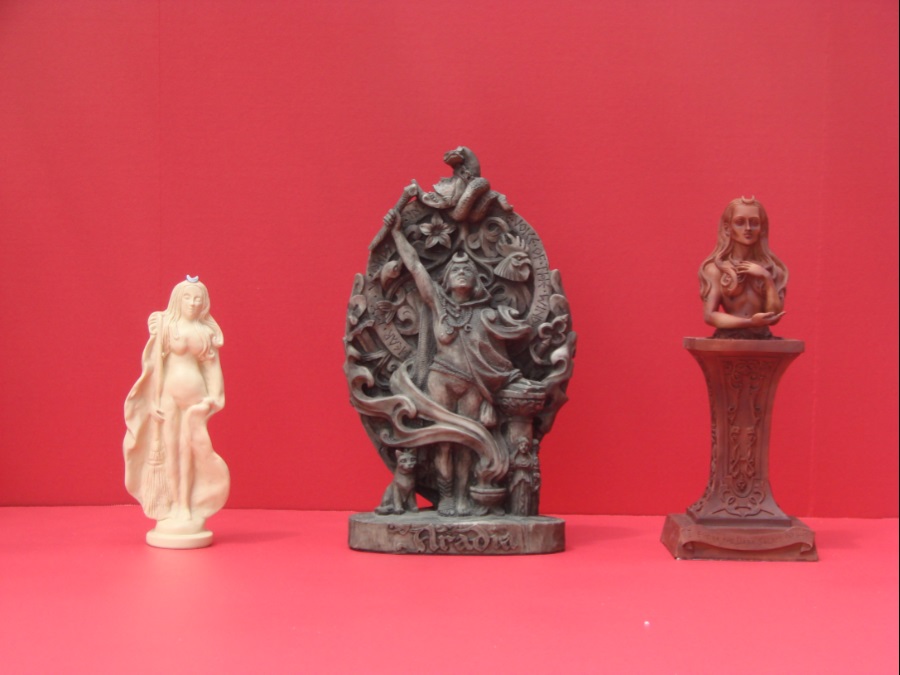
Unlike many other Goddesses adored and celebrated by the Neo-Pagan community, no pre-Christian images of her exist.
According to Dr. Sabina Magliocco, the written name, Aradia, does not appear in print until 1899, when the American folklorist Charles G. Leland published his now famous Aradia, or the Gospel of Witches.

According to Leland in his Appendix:
Aradia is evidently enough Herodias, who was regarded in the beginning as associated with Diana as chief of the witches. This was not, as I opine, derived from the Herodias of the New Testament...So far back as the sixth century the worship of Herodias and Diana by witches was condemned by a Church Council at Ancyra. --Aradia, or the Gospel of Witches, 1899, pp.103-104. [In the 19th century, it was commonly thought the Canon Episcopi dated back to the Council of Ancya in the 6th century, instead of the 9th or 10th century.]I am sharing what I believe to be two key quotes here from Sabina Magliocco’s informative article Who Was Aradia? The History and Development of a Legend, The Pomegranate: The Journal of Pagan Studies, Issue 18, Feb. 2002:
One of the earliest mentions of Herodias is in the work of Raterius of Liegi, Bishop of Verona (890-974 CE). He laments that many believe that Herodias, wife of Herod, is a queen or a goddess, and say that one third of the earth is under her charge (Bonomo, 1959:19).Dr. Magliocco also stated, “In medieval Italian, Herodias is rendered as ‘Erodiade,’ only a short linguistic step away from Aradia.”By the 14th century in Italy, Jacopo Passavanti first mentions the tregenda (sabbat)….He mentions that certain women believe they travel with this company, and that its leaders are Herodias and Diana (Bonomo, 1959:64). [The full name of the source she cited is Giuseppe Bonomo, Caccia alle streghe, 1959. (The title translation via Google: Hunting Witches or Witch Hunt.)]
Leland's Aradia is the daughter of the Roman Goddess Diana. She is born from the union of the sun and the moon.
Historically, Erodiade/Aradia does have ties to Italian folklore surrounding the "game of Erodiade", the "Game of the Good Society", and the "Game of Benevento". She is one of the mysterious Witch Queens who ruled over the Night Assembly.
These three images of Aradia have iconography tied to both modern Wiccan lore and old Italian folklore. They are by three different artists. The images represent the Wiccan Moon Goddess, and the Italian Queen of the Witches. She is the Maestra (Teacher), who teaches her followers the ways of magick and the veneration of Diana in the Old Religion (la vecchia religione).
ABOUT THESE THREE IMAGES
These three images are by three different artists. The images represent three different insights into the nature of Aradia, via form and symbolism.
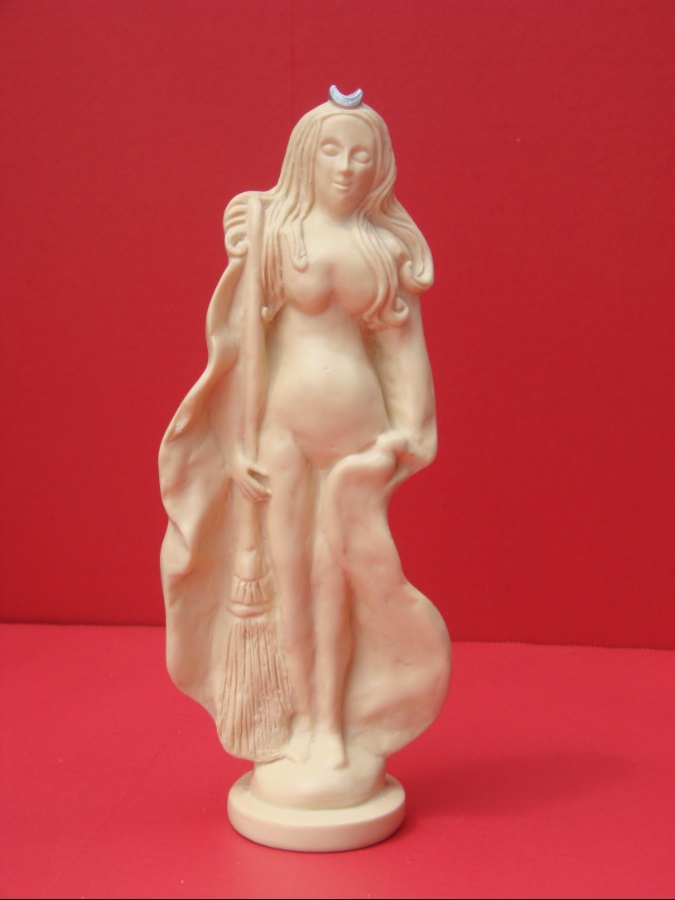 |
I. Aradia by Abby Willowroot copyright 1999 Abby Willowroot
8 3/4" gypsumstone statue, ivory color finish with painted crescent moon.
Sacred Source image MWG
"Aradia, Daughter of the Moon, Queen of the Witches, The Dianic Goddess - Strong, lovely and charismatic, Aradia (her name is derived from Herodias/Erodiade, queen of witches) was the daughter of moon goddess Diana. She is a timeless spiritual entity, embodying Kore in her power, Aphrodite in her beauty, and Diana in her courage and love of wild places. She was sent to Earth as prophetess of the religion of Witchcraft, with the mission of protecting women from the oppressions of feudalism. With her broomstave of power, her cloak of mystery, and her knowledge of every plant, she gave fright to the Inquisition. Aradia taught women how to invoke the full moon at midnight, sprinkling salt from a red bag while asking favors of the Goddess. With quiet authority she proclaims "Never Again the Burning!" Note the small pentacle on reverse of Aradia's cloak-hem." --text from the Sacred Source website, accessed 5/5/2019
My interpretation of this image is Aradia depicted as the crescent crowned, skyclad Wicca Moon Goddess.
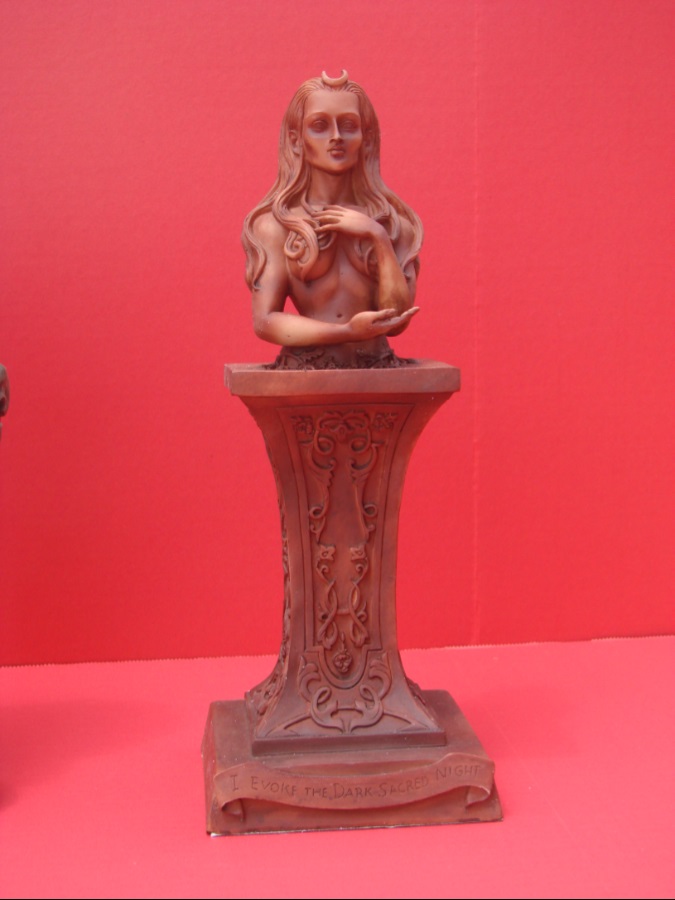 |
"A stunningly detailed bust of the Crescent Crowned Goddess in wood finish for our Crossroads Collection. The elaborate pedestal bears a banner on the front with the inscription 'I evoke the Dark Sacred Night.' A matching banner on the back bears the names of Raven Grimassi & Stephanie Taylor whose work and practice inspired the piece designed by artist Maxine Miller." --from House of Grimassi page of Raven's Loft website
This image of Aradia/Diana was fashioned in the style of one of the Roman termini (sacred pillars). Generally, a term (singular of termini) is a sculptured pillar that has a bust or head at the top. During the later Italian Renaissance, a term would instead include the body, from the waist up, of an image, as well as the head. In modern visual arts, the sculptural designation term is specifically a figure/bust atop a stone column, which tapers down to a quadrangular base.
The ancient Romand term is akin to the ancient Greek herm. Yet the word term was an abreviation of the name, Terminus, the Roman God of boundaries.
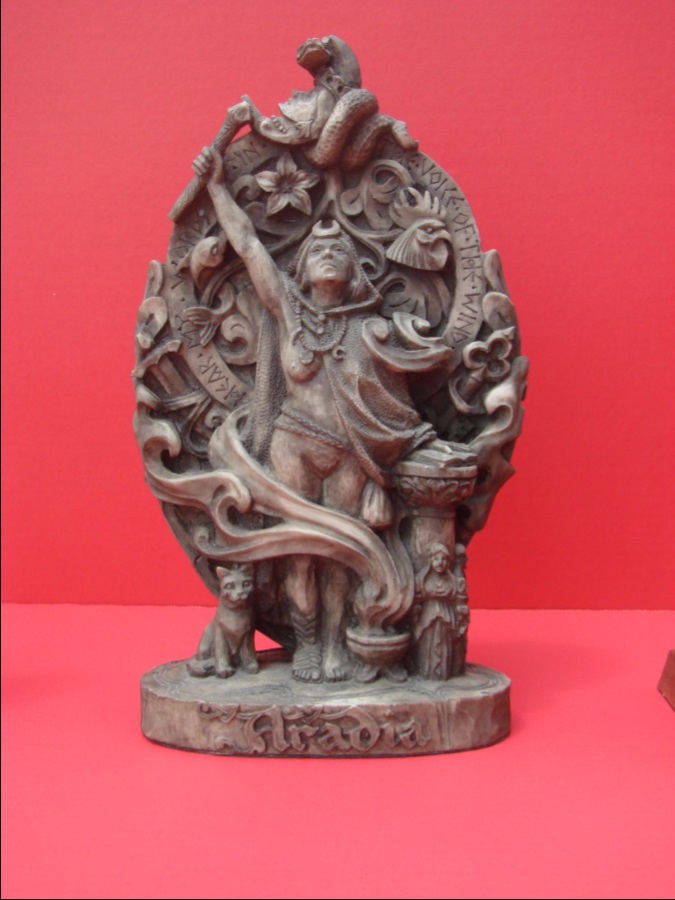 |
III. Aradia by Paul Borda, copyright 2007 P. Borda
Polyresin casting of an original design carved from mahogany by Paul Borda. Dryad Design www.DrayadDesign.com
"Aradia, 'Queen of the Witches,' is believed to have been a real high-born woman who taught witchcraft to the oppressed people in Italy, despite persecution. Legend tells us she was the daughter of the Goddess Diana, sent to care for her worshippers. Here Aradia calls on Diana to bless and inspire her teachings as she stands at the crossroads by the pillar of Hecate. Cimaruta symbols surround and support her. The inscription reads, 'Listen to my teaching in the voice of the wind.'" --text from the tag attached to the image
This image is clearly marked with the name Aradia. As the tag with the image noted the figure of this Goddess is surounded with symbols associated with the cimaruta, the Italian anti-malocchio protective charms: the horned crescent, the serpent, the key, the cock (rooster), the sword, the five petaled vervain (Verbena officinalis), etc. [Common vervain (Verbena officinalis) has been held in high esteem since classical antiquity; it has long been associated with divine forces.]
The name cimaruta, in Neapolitan means, "sprig of rue," meaning the plant rue (Ruta graveolens). Rue, according to Frederick Thomas Elworthy in his The Evil Eye (1895), “is one of the very oldest of existing amulets.” It was used in Roman times, and Elworthy suspected its origins were older. He also associated the cimaruta, directly with the Roman Goddess Diana. In the blockquote below from Elworthy’s book, please note the words with an asterisk after them were written in Greek letters. I used Google translate to trans literate the letters of the words. The Greek names are clearly “Selena”, “Artemis”, and “Persephone”—and “triform” meaning three-formed. [I have done this to the quote because I have no good way to reproduce the words with Greek letters.]
In all the complete specimens [Cimarutas] here produced (Figs. 81, 162), it will be seen that the Cimaruta has three main branches; and considering the material of which these charms are always made, in connection with the other symbols on this complex object, we can come to no other conclusion than that the three branches are typical of Diana Triformis or of her prototype….Diana, who being in three different capacities, as conversant in heaven, earth, and hell, has three distinct names: in heaven she is Selini*, the Moon; upon the earth Artemis*, Diana; in hell Persefioni*, Proserpine; whence are those epithets whereby the poets denote her threefold character as triform*, triformis, tergemina with several others.The 1895 quote above ought to provide an interesting insight about how some 19th century flolklorists studied and interpreted the symbolism of the cimaruta and connected it to the figure of Diana Triformis in ancient Roman/Latin religion.Considering her in another threefold character, she is Hecate, Diana, Proserpine. --Frederick Thomas Elworthy, The Evil Eye, (1895) p. pp 350- 351.
At this point, I will share another important quote, only this one is from a 21st century source:
One of the most famous lunar goddesses of human culture, Selene had been a subject of oral tradition for many centuries. By the time of Sappho [circa 630-570 bce], Selene was considered not merely a lunar goddess, but one and the same with the Moon itself. A few centuries later, the Greeks would come to associate Selene with Artemis, twin sister of Apollo, and with a goddess of witchcraft called Hecate. This would transform Artemis and Hecate [Greek spelling: Hekate] into lunar goddesses as well, but unlike Selene they were not personifications of the Moon. --David Warmflash, Moon: An Illustrated History: From Ancient Myths to the Colonies of Tomorrow , 2019, p.37; this quote is found in 7th Century BCE Earliest Mention of Selene.As Frederick Thomas Elworthy noted in the 19th century this three-formed Goddess was: Selene in the sky, Artemis upon the earth, and in the underworld Persephone; in Roman mythology, she was Luna in the sky, Diana upon the earth, and in the underworld Proserpine.
However---according to David Warmflash—sometime in the 7th bce the three Goddesses associated with each other were Selene (sky), Artemis (earth), Hekate (underworld). Transferred over to Roman lore, the divine lunar triad have been Luna in the sky, Diana on the earth, and Hecate, in the underworld.
When Hecate became venerated in Rome, she was viewed as having a chthonic/ underworld nature. In Italy, the luci averni, woods surrounding Lake Avernus, were sacred to Hecate. The Cave of the Cumaean Sibyl was located near this area—and was one of the entrances to the Roman chthonic underworld.
True, Leland never mentioned the Roman Hecate in Aradia or the Gospel of the Witches, 1899.Leland does make clear that the moon, Diana, is in the sky and her daughter, Aradia, is on the earth…but who reaches to the underworld.
Thus, the lunar triad of Goddesses—as venerated among some Wiccans and Neo-Pagans--is Diana in the sky, Aradia on the earth, and Hecate, in the underworld. Hecate had many similarities to Diana. She traveled at night with a pack of hounds. She was described as a triune deity. Hecate Trivia stood at the cross roads where three roads met.
The names Diana and Hecate are also upon this image of Aradia, seem to indicate the artist Paul Borda depicted the union of the three-fold Goddess: upon the earth, Aradia the Teacher; in heaven, Diana; and Hecate Trivia at the Three Roads.
Aradia, as the daughter of Diana, is frequently portrayed in contemporary Wiccan art with a crescent upon her brow. The word crescent is etymologically derived from the present participle of a Latin verb crescere "to grow", technically denoting the Waxing Moon (luna crescens). The crescent is borrowed from her mother, Diana...or is it?
All three of these images of Aradia are crowned with a crescent Moon, indicating the waxing lunar phase of the first quarter--sometimes called “the sickle moon." With both points of the crescent up, the Waxing Moon is also known as “the horned crown.”
A crescent was the traditional emblem of several Moon Goddesses. Diana (Roman)/Artemis (Greek) was often depicted as wearing the crescent on her forehead as was Luna (Roman)/Selene (Greek).
Hecate (Roman)/Hekate (Greek) was associated likewise with the Full Moon as well as with magic. However, I do not recall any image of Hecate wearing a Waxing Crescent Moon upon her forehead.
In 20th - 21st century tradition, the Wiccan “horned crown” is worn by a High Priestess as part of ritual garb in the Alexandrian Tradition; this practice is also found in some other Trads in Wicca.
If you wish to examine more details of III. Aradia by Paul Borda, please see the photos at the very end of this article.All photos and text, except where otherwise attributed, copyright Myth Woodling 2019. We respect all copyrights belonging to the artists and creators of these images; all rights reserved.
Since a picture is worth a thousand words, here are links:
Image: 19th century Erodiade Painting
Image: 14th century Erodiade Regina
Image: 21st Century Daughter of Herodias (This figure is a Catholic depiction of the daughter of Herodias, from Holy Week processions in the Philippines. )
Image: 20th century tile image from Aradia's Gallery
Charms and Sacred Jewelry: Aradia "Witch Goddess" Pentagram Pendant
Charms and Sacred Jewelry: Lunar Goddess Necklace
Charms and Sacred Jewelry: Cimaruta
Altar Honoring Aradia and Cernunnos
Aradia Shrine at FSG 2016
Since words provide information, here are more important links:
Who Was Aradia? by Dr. Sabina Magliocco
Raven Grimassi Aradia - Stregheria(dot)com (There is also a great painting with this article; see the link above to “Image: 19th century Erodiade Painting”)
Farrar-Alexandrian Invocation of Aradia in Italian
Zsuzsanna E. Budapest, The Goddess Speaks: Aradia from the book, Grandmother Moon 1991 (pp 86-87).
Jonathan Sousa, Erodiade Invocation2015, Jonathan Sousa is a stregone (sorcerer), which often also indicates a practitioner of the Old Religion. Jonathan Sousa is likewise a priest of the ancient Italian Goddess Diana.
The Secret Story of Aradia as told by Myth Woodling
The Crescent Cakes of Aradia contains an interesting retelling of the story of Aradia’s birth taken from a personal Wiccan Book of Shadows, collected 1991.
Retelling of the Dance of Herodias's Daughter
The Beautiful Pilgrim I could never find an Italian folktale about La Bella Pellegrina (The Beautiful Pilgrim), so I wrote one using motifs found in Italian folktales about visiting saints, angels, or holy men who requested shelter for the night.
Close-ups of Aradia image by Paul Borda
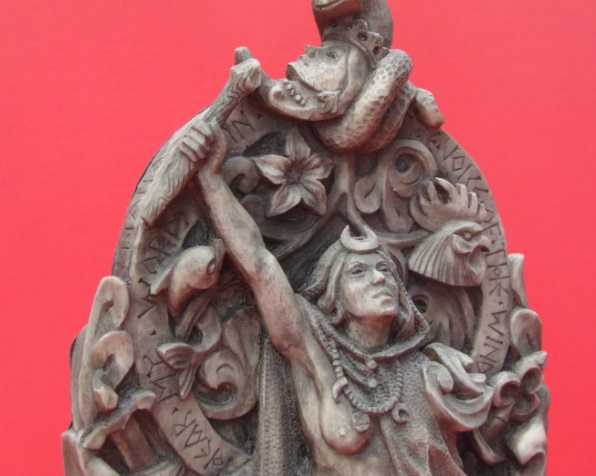 |
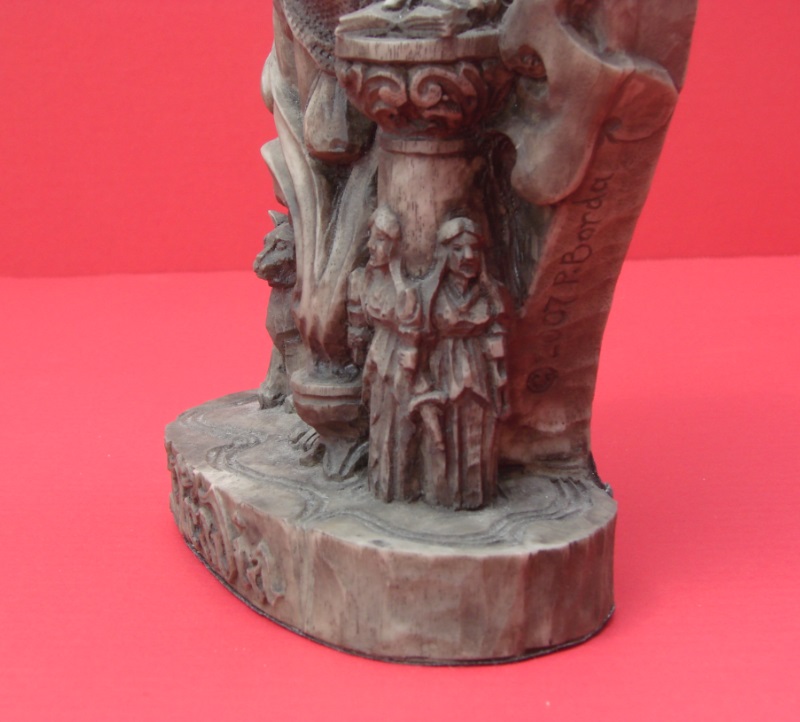 |
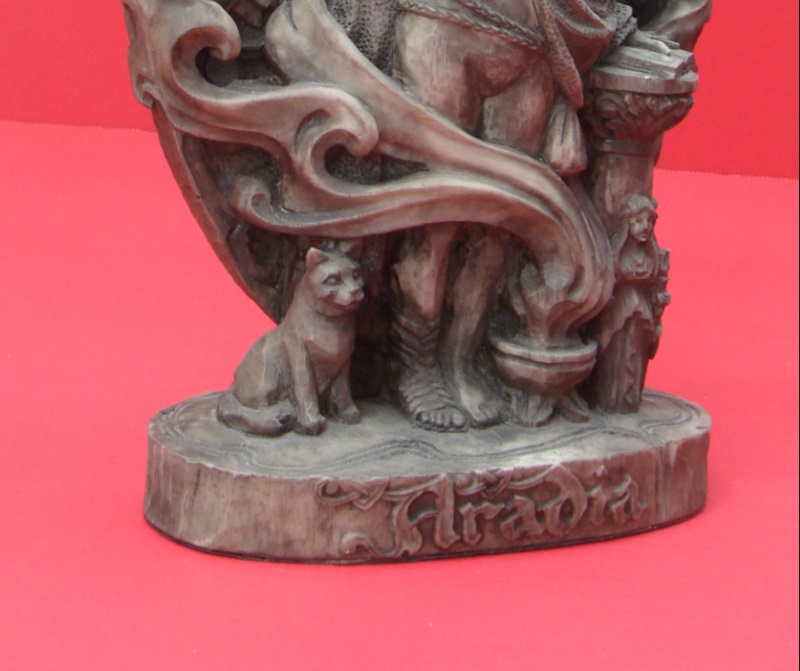 |
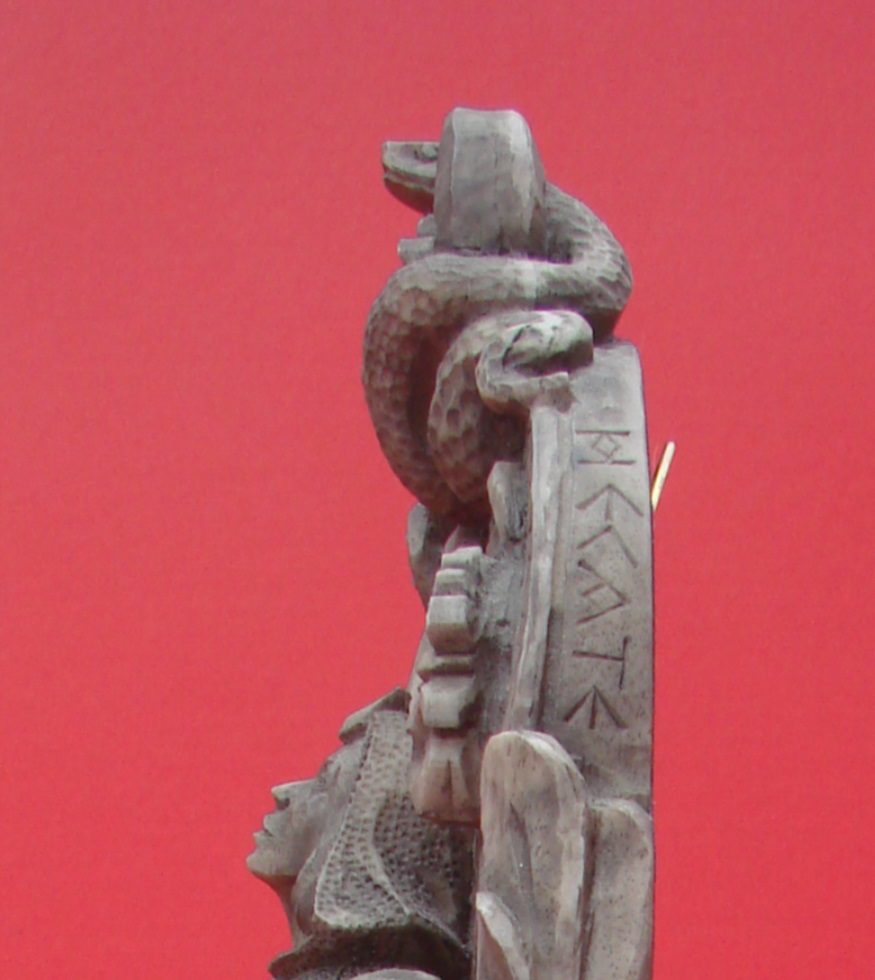 |
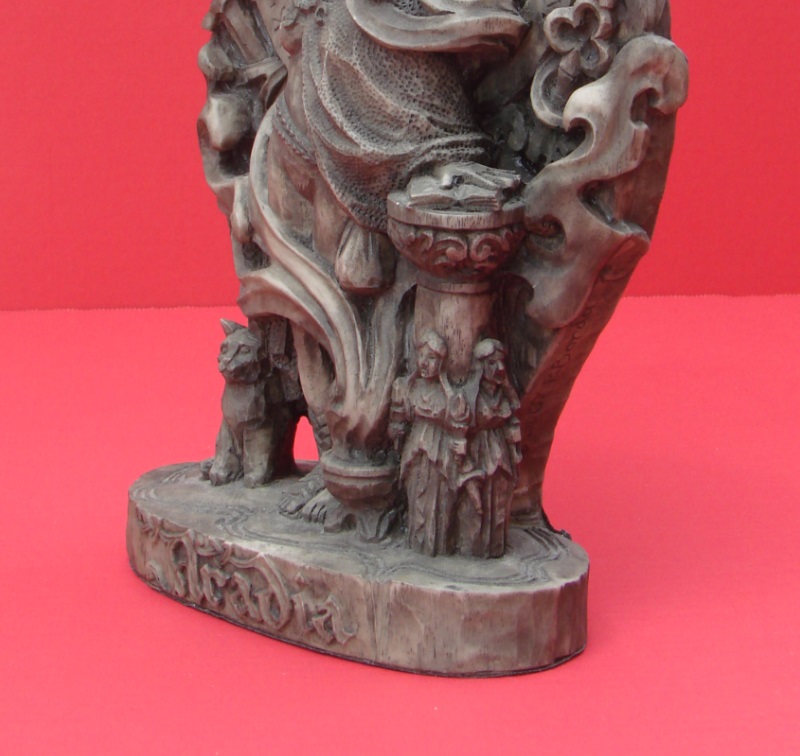 |
Sources:
The Editors of Encyclopaedia Britannica, Term Architecture and Sculpture, April 1, 2011.
Sabina Magliocco, Who Was Aradia? The History and Development of a Legend, The Pomegranate: The Journal of Pagan Studies, Issue 18, Feb. 2002.